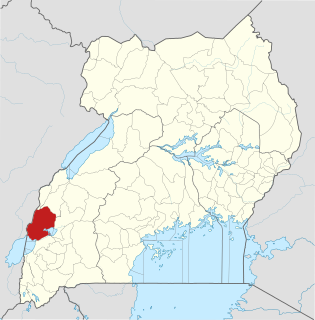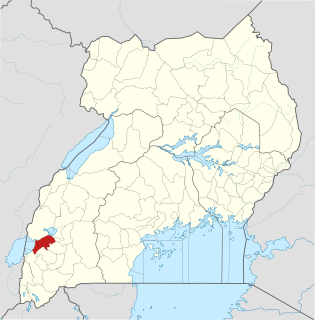Related Research Articles

Uganda, officially the Republic of Uganda, is a landlocked country in East Africa. It is bordered to the east by Kenya, to the north by South Sudan, to the west by the Democratic Republic of the Congo, to the south-west by Rwanda, and to the south by Tanzania. The southern part of the country includes a substantial portion of Lake Victoria, shared with Kenya and Tanzania. Uganda is in the African Great Lakes region. Uganda also lies within the Nile basin and has a varied but generally a modified equatorial climate. It has a population of over 42 million, of which 8.5 million live in the capital and largest city of Kampala.
The history of Uganda comprises the history of the people who inhabited the territory of present-day Uganda before the establishment of the Republic of Uganda, and the history of that country once it was established. Evidence from the Paleolithic era shows humans have inhabited Uganda for at least 50,000 years. The forests of Uganda were gradually cleared for agriculture by people who probably spoke Central Sudanic languages. In 1894, Uganda became a protectorate of the British Empire, and in 1962 the United Kingdom granted independence to Uganda making Sir Edward Muteesa Walugembe to be the first President of Uganda and Kabaka of Buganda. Idi Amin deposed Milton Obote in 1971 to become ruler of Uganda, a position he would occupy until he was ousted in 1979 as a result of the Uganda-Tanzania War. After a series of other leaders, Yoweri Museveni came to power in 1986 and has led Uganda since that time.

Buganda is a Bantu kingdom within Uganda. The kingdom of the Baganda, Buganda is the largest of the traditional kingdoms in present-day East Africa, consisting of Buganda's Central Region, including the Ugandan capital Kampala. The 12 million Baganda make up the largest Ugandan region, representing approximately 26.6% of Uganda's population.

The Protectorate of Uganda was a protectorate of the British Empire from 1894 to 1962. In 1893 the Imperial British East Africa Company transferred its administration rights of territory consisting mainly of the Kingdom of Buganda to the British government.

Kasese District is a district in Western Uganda. Like most other Ugandan districts, the town of Kasese is the site of the district headquarters.

Kibaale District, is a district in the Western Region of Uganda. The district headquarters are in the town of Kibaale.
Nkore is a Bantu language spoken by the Nkore ("Banyankore") of south-western Uganda in the former province of Ankole.

Ibanda District is a district in the Western Region of Uganda. The town of Ibanda is the site of the district headquarters.
Jjunju Sendegeya was Kabaka of the Kingdom of Buganda from 1780 until 1797. He was the twenty-sixth (26th) Kabaka of Buganda.
Rukirabasaija Daudi Kasagama Kyebambe III was Omukama (King) of the Kingdom of Toro from 1891 until 1928. He was the tenth (10th) Omukama of Toro.

Mpanga Power Station is an 18 megawatts (24,000 hp) mini hydroelectric power project located across River Mpanga, in Kitagwenda County, Kamwenge District, in Western Uganda.

The Ganda people, or Baganda, are a Bantu ethnic group native to Buganda, a subnational kingdom within Uganda. Traditionally composed of 52 clans, the Baganda are the largest ethnic group in Uganda, comprising 16.5 percent of the population at the time of the 2014 census.

Rubirizi District is a district in Western Uganda. Like most Ugandan districts, the district is named after its 'chief town', Rubirizi, where the district headquarters are located.

Mpanga is a location on River Mpanga in Uganda.

Saint Paul's Cathedral Namirembe, commonly referred to as Namirembe Cathedral, is the oldest cathedral in Uganda. It serves as the provincial cathedral of the Church of Uganda and the diocesan cathedral for Namirembe Diocese, the first diocese to be founded in the Church of Uganda province, in 1890. Between 1919 and 1967, the Cathedral served as the provincial cathedral of the Church of Uganda, Anglican Communion. In the 1960s, the headquarters of the Church of Uganda moved to All Saints Church in Nakasero then moved back to Namirembe later.
The New Year Honours 1900 were appointments by Queen Victoria to various orders and honours of the United Kingdom and British India.

Kitagwenda District is a district in Western Uganda. The district is named after Kitagwenda County, which is coterminous with the district.

Ntara is a settlement in Kitagwenda District, in Western Uganda. It is the political, administrative and commercial headquarters of the district. Ntara is one of the two municipalities in the newly-created Kitagwenda District, the other being Kabujogera Town Council.

Kabujogera is a settlement in Kitagwenda District, in Western Uganda. It is one of the two municipalities in the newly-created Kitagwenda District, the other being Ntara Town Council, where the district headquarters are located.

Turkey has an embassy in Kampala. Uganda has an embassy in Ankara.
References
- ↑ Efuraimu, Kamuhangire Rwumva (1995). The Pre-colonial History of the Salt Lakes Region of South Western Uganda, C.1000-1900 A.D. Gideon S. Were Press.
- ↑ Wheeler, Andrew (1971). Kitagwenda, a Babito Kingdom in Southern Toro.
- 1 2 The International Journal of African Historical Studies. Africana Publishing Company. 1973.
- ↑ Annalen: Menselijke wetenschappen. Reeks in-8o. Musée royale de l'Afrique Centrale. 1977.